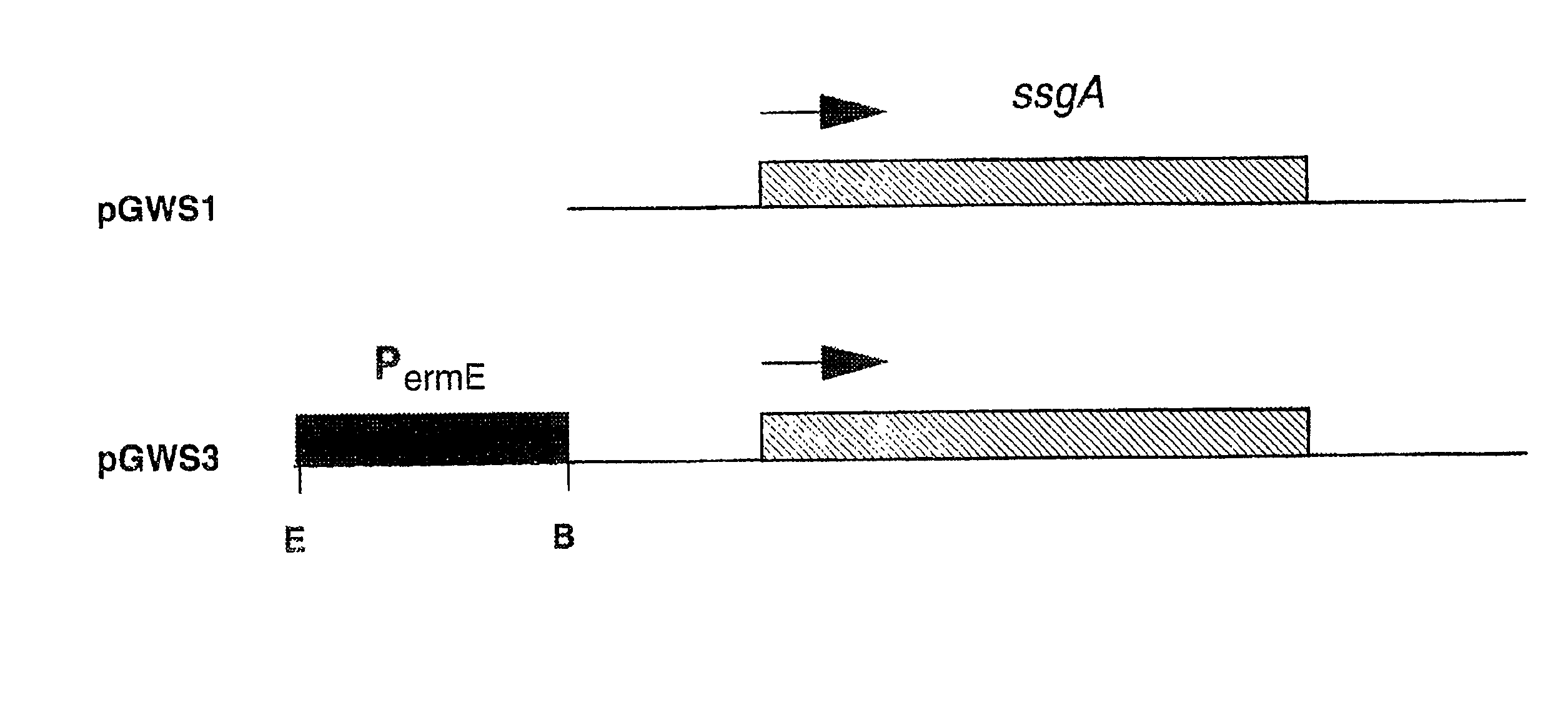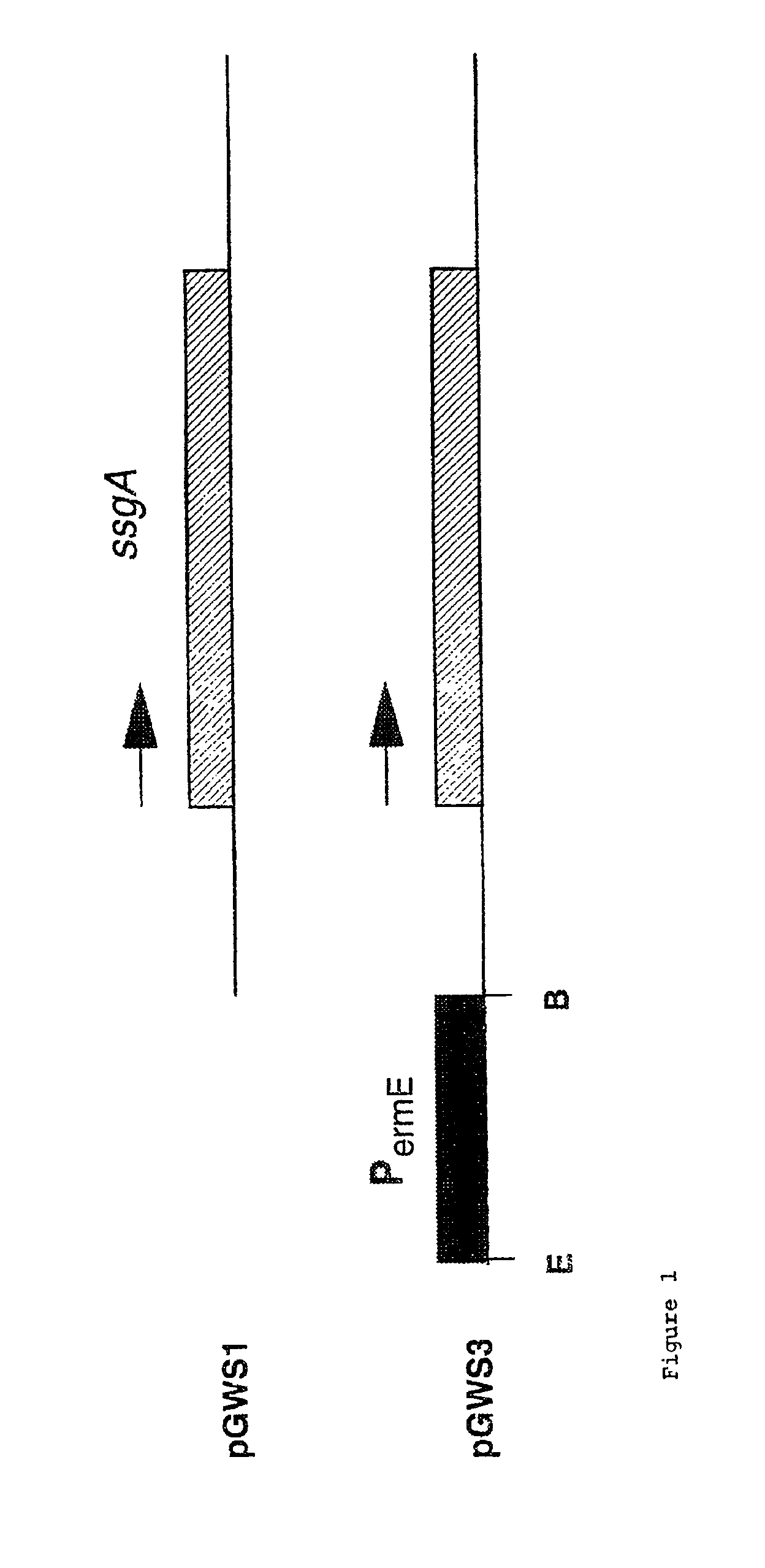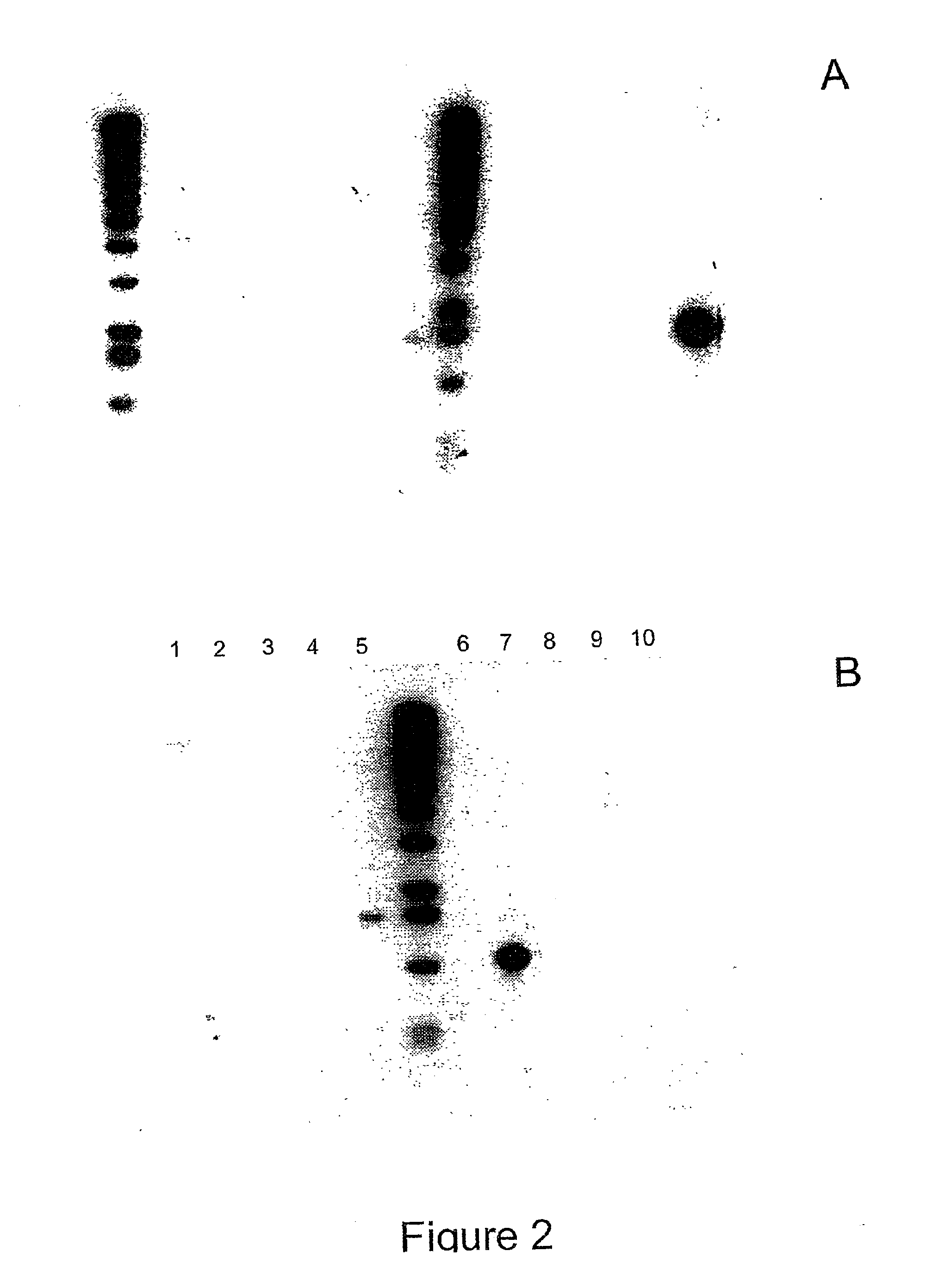[0007]The present inventors have shown that the activity of SsgA from S. griseus is not limited to the
organism in which it is found. The activity can advantageously be transferred to other organisms, thereby allowing more fragmented growth and / or reduced branching and / or
reduced viscosity of the culture of many filamentous microorganisms, in particular actinomycetes and steptomycetes. This special growth behaviour is observed in a wide variety of
culture mediums. It is particularly surprising, that organisms in which a significant endogenous ssgA-like activity is not detectable still respond to the presence of the product of the ssgA
gene. Thus we demonstrate that introduction of ssgA into various
bacteria, in particular actinomycetes that lack significant endogenous ssgA activity results in suppressed branching and enhanced fragmentation of the
mycelium in
liquid culture, resulting in significantly lower
viscosity of culture broths. In addition to autonomously replicating plasmids containing constitutively expressed ssgA, we devised a
system that allows easy integration of the
gene in the
chromosome, with the
advantage of high stability combined to that of independent regulation of ssgA.
[0010]As explained above the presence of additional SsgA activity, in particular
heterologous SsgA-activity (meaning activity not in a form as present in the
microorganism in nature), irrespective of the presence or absence of endogenous SsgA activity, leads to enhanced fragmentation, reduced branching and thus
reduced viscosity in a wide range of
culture mediums. The activity may be provided in any suitable manner, but it is preferred that the activity is provided by transfecting or transforming said filamentous bactrium with additional genetic information encoding said activity. Examples of such methods are presented hereinbelow, but the art of
genetic engineering of
bacteria is so well advanced that persons skilled in the art will be able to come up with numerous methods and variations thereof to provide an intended filamentous bacterium with a
gene encoding SsgA-like activity. SsgA-like activity is functionally defined as the ability to enhance septation, fragmentation and / or reduce branching in (typically) submerged cultures of filamentous microorganisms, in particular bacteria, more specifically actinomycetes. The activity of other ssgA-like genes or fragments of ssgA genes or derivatives of ssgA genes which are within the invention must be functionally the same, but that does not mean that the amount of activity per molecule needs to be the same. SsgA-like activity is thus defined as similar in kind, though not necessarily in amount. Other genes encoding such SsgA activity than the genes disclosed herein can be obtained without departing from the invention by applying routine hybridization and / or amplification techniques. Means and methods for expressing such genes are well known in the art so that there is no need to go into detail here regarding
cloning vectors, expression vectors, (inducible) promoters, enhancers, repressors, restriction enzymes, etc. etc. For stability of the presence of the added SsgA-activity to the bacterium, in particular for application in large scale fementations, it is however preferred that the genetic information encoding the additional SsgA activity is integrated into the host
cell genome. In this case typically the genetic information will be in the form of
DNA. However, neither
RNA, heteroduplexes or even PNAs are excluded from the present invention as means to provide the additional genetic information to a
microorganism. The invention is preferably applied in the field of filamentous bacteria, in particular actinomycetes and most specifically to streptomycetes. In these embodiments in particular it is preferred to apply ssgA genes derived from actinomycetes, especially from other actinomycetes than the one to be altered in growth characteristics. This of course is automatically the case in a bacterium that does not have SsgA activity to any significant amount itself. Using a gene from a related
organism enhances the compatibility of the expression machinery of the host with the gene. Thus it is particularly preferred to provide a
Streptomyces with an ssgA (-like) gene from a different Streptomyces. SsgA genes are found in
Streptomyces griseus, Streptomyces collinus,
Streptomyces albus, Streptomyces goldeniensis and Streptomyces netropsis. It is preferred to provide Streptomyces strains not having significant endogenous SsgA activity with a gene from the earlier mentioned strains.
[0011]It is useful to ensure that said additional SsgA activity is inducible or repressible with a
signal. In this way the growth characteristics of the bacteria can be modified at will. Of course the final goal of the present invention is to enhance the production of useful products by the microorganisms by modifying the microorganisms according to the invention. Useful products produced by or through microorganisms according to the invention include so called secondary metabolites, typically
antibiotics or antitumour agents, but also immunosuppressive agents, hypocholesterolemic agents,
enzyme inhibitors, antimigraine agents, herbicides,
antiparasitic agents,
ruminant growth promoters, bioinsecticides,
receptor (
ant)agonists, hetreolgous proteins or even simple
biomass. In the case of Streptomycetes such a useful product is typically an antibiotic. It is thus therefore preferred according to the invention to modify antibiotic producing strains of Streptomyces, particularly those not displaying a significant endogenous SsgA like activity, with genetic information encoding SsgA activity. On the other hand the invention can also be very suitably applied to Streptomycetes or other microorganisms expressing
heterologous proteins (or overexpressing homologous / endogenous proteins).
[0048]Expression of ssgA in S. coelicolor M145 results in reduced branching of the hyphae and fragmented growth
[0050]Transformants containing pWHM3-E (without ssgA) or pGWS2 showed little or no altered morphology in the complex liquid media TSBS, YEME, nor in minimal medium (MM), as judged by phase-contrast
microscopy (FIG. 3A). However, hyphae of transformants containing pGWS3 showed strongly reduced branching in complex and minimal medium cultures, resulting in clearly less dense mycelial lumps (FIG. 3B). The vegetative hyphae not only show limited branching, but many of the branches are less than a micron in length. When pGWS3-SD was used instead of pGWS3, the effect was even stronger, with small fragments appearing after approximately 30 hrs, which increased over time (FIG. 4). While MM cultures of S. coelicolor typically result in very large mycelial lumps that
sediment rapidly (virtually all
mycelium precipitates within one minute when shaking was stopped), MM cultures containing pGWS3-SD transformants showed significantly reduced
sedimentation rates, with the majority of the mycelium failing to
sediment within five minutes after shaking of the cultures was stopped.
[0056]Thus, it appears that
overproduction of SsgA has a strong effect on mycelium morphology in submerged cultures of actinomycetes, irrespective of the presence or absence of endogenous ssgA-like activities, with the vegetative hyphae showing much enhanced septation and restricted branching. Furthermore, the
ageing cultures showed an increasing degree of fragmentation, resulting in higher culture densities and lower
viscosity of recombinant streptomycetes expressing ssgA. Comparison of the phenotypes of the two categories of Streptomyces strains, namely those displaying ssgA activity and those without a significant level, is currently in progress, and could give us more insight into the role of SsgA in Streptomyces
physiology.
 Login to View More
Login to View More 


